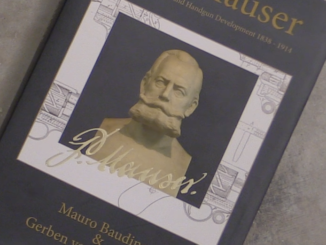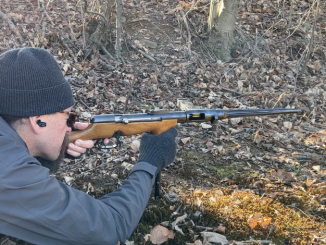Today we are looking at two suppressed CZ-27 pistols, one Polish and one German. The Polish one was issued by the Ministry of Public Security, an agency which only existed from 1945 until 1954. It uses an aluminum suppressor with 5 baffles and 5 rubber wipes, threaded onto an extended barrel. It is clearly not intended for precise shooting, as the sights do not clear the top of the suppressor!
The German pattern is substantially different. It was used by the Gestapo during the Nazi regime, and also by West German security services after World War Two. The suppressor is a non-disassemblable unit with a series of sheet metal baffles, and attached to a belled expended barrel. The rear of the suppressor has a circle of six flexible flanges that snap over the belled muzzle, and a threaded section which screws down over them to lock the unit in place. This suppressor also blocks the pistol’s sights, and so it was made with a set of sights on the body of the suppressor tube.
Thanks to the anonymous collector who provided me access to these two pistols!




My uncle (LtCol U.S. Army Corps of Engineers) brought one of these back from Germany. He thought the “bulged” barrel was a leftover from an incomplete machining process until I explained about the suppressor.
Its slide was marked exactly like the one shown on p. 580 of Ezell’s Handguns of the World;
fnh Pistole Modell 27 Kal 7.65
The “fnh” was the German HWA code for the CZ factory from June 1941. The designation on the one Ian showed;
Bohmische Waffenfabrik A.G. Prag
On the Polish pistol indicates manufacture between mid-1940 and June ’41. Before that, the “early occupation” slide marking was;
Ceska Zbrojovka A.S. Prague XXXXXX
The ‘X’s of course being the six-digit serial number.
A post-1948 CZ 27 would be marked
CESKA ZBROJOVKA-NARODNI PODNIK
STRAKONICE
In two lines, flanked by two circles, the front one containing the CZ trademark, the rear one with “7.65” inscribed in it.
All data from Ezell, pp 580-81.
cheers
eon
VHU PRAHA has example of ČZ vzor 27 s tlumičem
http://www.vhu.cz/exhibit/cz-vzor-27-s-tlumicem/
which has text:
fnh Pistole Modell 27 Kal. 7.65
In description Arado firm is mentioned, which is probably Arado Flugzeugwerke (unless there existed another entity named Arado which I do not know)
(don’t ask me why Germans asked aeroplanes factory in Germany to develop suppressor for Czechoslovak automatic pistol)
If I understand correctly name for this suppressor is Haube L 31 and itself is part of bigger project Haube (suppressor for hand weapons)
Oh great, more political police! I suppose getting a visit from them would have a cliche scenario from the movies.
“You can’t fool me with this secrecy crap, I know my rights!”
“And now, you know too much!” Cue the guys in trench coats and hats. All with suppressed guns, ready to make an “accident” happen…
Nothing spells ‘point blank assassination tool’ like rubber wipes in a suppressor that blocks the sights. Cops make the best hitmen I guess. If they do get caught they only have to flash their badge.
“Dead or alive, you’re coming with me!” Is that a potential “arrest” line?
Generally, a suppressor with rubber “wipes” will provide about 20dB reduction, while one with metal baffles will only be good for about 10dB. The baffles are fairly durable, probably lasting about 100 rounds with subsonic ammunition. The “wipes” will probably be blown out after 20 rounds.
Neither dB reduction sounds like much, until you consider the the decibel scale is geometric. A 10 point reduction is actually 1/10th the intensity; 20 points is 1/100th. As here;
https://www.dakotasilencer.com/wp-content/uploads/2014/05/Silencer_Sound_Comparsion_chart.pdf
As for various “environmental” sounds other than firearms, some of them can be pretty intense;
http://www.noisehelp.com/noise-level-chart.html
While Hollywood maintains that a “silencer” can eliminate all sound of firing, or at most result in about the noise of going “poo!” with a breath of air between your lips, the best that you will likely get in the real world is reducing a subsonic round’s sound to about that of an air gun. If the bullet leaves the muzzle of the silencer at any velocity above mach 1 (~1,090 F/S), there will be a ballistic “crack”- literally a tiny “sonic boom”.
NB; most silencers which relied on “wipes” were like the Polish one Ian showed; they were designed to be easily dismantled and generally came with one or two complete sets of replacement “wipes”.
The most “indestructible” firearms suppressor in service is probably that on the H&K MP5SD. The back section is simply a special barrel with radial holes drilled in it and a tubular expansion chamber. The front section looks like this;
http://www.cncguns.com/images/mp5sd.jpg
The combination provides 12 – 15dB suppression, and also reduces standard supersonic velocity 9 x 19mm at 1,250 F/S to below the 1,090 F/S threshold, eliminating ballistic “crack”.
It looks almost too simple and mule-stupid to work, but it does nevertheless.
cheers
eon
Taking in account serious size of working suppressor in Soviet Union internally silenced cartridge were prefer over classic cartridge + suppressor where small size was needed, example of such weapon is MSP: https://modernfirearms.net/en/handguns/handguns-en/russia-semi-automatic-pistols/msp-besshumnyj-eng/
(notice it size watching on 3rd picture from top)
yet it was not as noiseless as can be but also totally flash-less
Though not introduce operationally before end of Great Patriotic War such weapon were created, of note might be Бесшумный револьвер Гуревича see images:
http://zonwar.ru/news5/news_901.html
developed from 1943, belong to rare group of “hydraulic” weapon (see drawing)
Earlier development was noiseless revolver created by inventors of BraMit suppressor, see 1st image from top here:
http://stechkin.info/article/107
it was derived from Nagant revolver and has 2 cylinders, bullets have sabots which were catch in front cylinder.
Patented 1929.
Mach number is unit-less because it compares flow velocity through a boundary to the local speed of sound. The speed of sound depends on the physical properties of a fluid. M=u/c, where ‘u’ is the flow velocity of a fluid and ‘c’ is the speed of sound of the fluid as a medium. Speed ‘c’ depends on fluid properties, such as temperature, mass density (or molar density), specific heat capacity, etc. I would elaborate on those details, but then I’d have to break out my books on aerodynamics (each textbook weighs at least 5 lbs and would bore you out of your mind)!
I know, I have the same books. I just gave the figure for sea level pressure at 60 deg. F, which is pretty much standard when dealing with firearms velocities. Few of us will ever fire a handgun at 45,000 feet at -35 F.
The general “rule of thumb” is 1,086 f/s or 330 m/s, for most calculations in this area.
cheers
eon
Are you sure that is a West German CZ, and not an East German? West Germany didn’t have any Federal police or intelligence agencies until the 50s.
Don’t forget Gen. Gehlen and his group. They transferred their loyalties- and their network- to U.S. Army Intelligence almost as soon as Hitler was dead. (Gehlen didn’t like or trust the Soviets, and he trusted Donovan’s OSS even less.) As Len Deighton put it, most of Gehlen’s people didn’t even miss a paycheck.
So there’s a very good chance that since they kept on “working” right through the occupation period, arms like this would have been in their inventory.
cheers
eon
Well, they were *secret*.
The german mounting method is cool
I had a similar unit on a 5mm remington magnum once no bulge though and at the fifth round the silencer became a rifle grenade
The still silencers in france made a similar mounting unit for a shotgun silencer in 9mm flobert 12mm/410 and 14mm shot cartriges.It was made specificly for the manuarm single shot bolt action shotguns
I made a mounting system for a 14mm shotgun using a coupling conceived to connect copper water pipes together We cut a small groove just back from the end of the barrel and the olive compression joint fitted into it
It worked/is still working very well
A side note sillencers are now regulated in france but they have just been authorized for hunting
German “secret police” never gm had access to suppressed weapons…..
German special forces used this gun NOT GESTAPO
MBP this cyrylic bulgarian pistol Министерството на вътрешните работиMinistry of the Interior – Bulgarian Министерството на вътрешните работи MWR